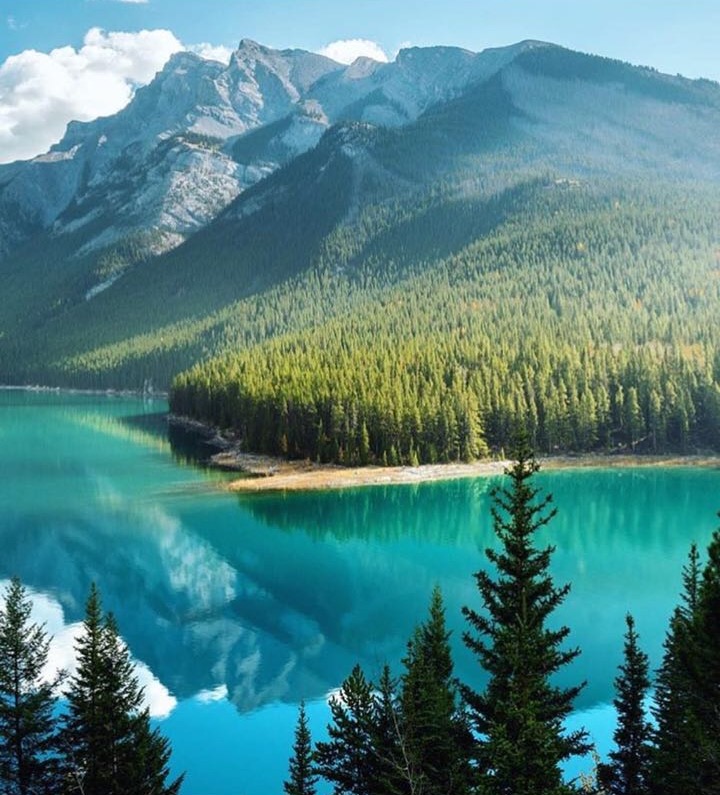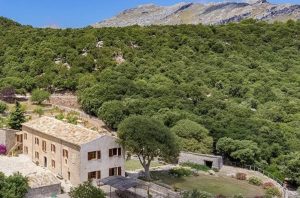
Banff National Park /ˈbæmf/ is Canada’s oldest national park, established in 1885 in the Rocky Mountains. The park, located 110–180 kilometres (68–112 mi) west of Calgary in the province of Alberta, encompasses 6,641 square kilometres (2,564 sq mi)[2] of mountainous terrain, with numerous glaciers and ice fields, dense coniferous forest, and alpine landscapes. The Icefields Parkway extends from Lake Louise, connecting to Jasper National Park in the north. Provincial forests and Yoho National Park are neighbours to the west, while Kootenay National Park is located to the south and Kananaskis Country to the southeast. The main commercial centre of the park is the town of Banff, in the Bow River valley.
The Canadian Pacific Railway was instrumental in Banff’s early years, building the Banff Springs Hotel and Lake Louise Chalet, and attracting tourists through extensive advertising. In the early 20th century, roads were built in Banff, at times by war internees from World War I, and through Great Depression-era public works projects.[3] Since the 1960s, park accommodations have been open all year, with annual tourism visits to Banff increasing to over 5 million in the 1990s.[4] Millions more pass through the park on the Trans-Canada Highway.[5] As Banff has over three million visitors annually, the health of its ecosystem has been threatened. In the mid-1990s, Parks Canada responded by initiating a two-year study, which resulted in management recommendations, and new policies that aim to preserve ecological integrity.
Banff National Park has a subarctic climate with three ecoregions, including montane, subalpine, and alpine. The forests are dominated by Lodgepole pine at lower elevations and Engelmann spruce in higher ones below the treeline, above which is primarily rocks and ice. Mammal species such as the grizzly, cougar, wolverine, elk, bighorn sheep and moose are found, along with hundreds of bird species. Reptiles and amphibians are also found but only a limited number of species have been recorded. The mountains are formed from sedimentary rocks which were pushed east and over newer rock strata between 80 and 55 million years ago. Over the past few million years, glaciers have at times covered most of the park, but today are found only on the mountain slopes though they include the Columbia Icefield, the largest uninterrupted glacial mass in the Rockies. Erosion from water and ice have carved the mountains into their current shapes.
Banff National Park is the most visited Alberta tourist destination and one of the most visited national parks in North America, with more than three million tourists annually.[67][68] During summer, 51 percent of park visitors are from Canada (30 percent from Alberta), while 31 percent are from the United States and 14 percent from Europe.[69] Tourism in Banff contributes an estimated C$6 billion annually to the economy.[70]
A park pass is required for stopping in the park and permit checks are common during the summer months, especially at Lake Louise and the start of the Icefields Parkway. A permit is not required if travelling straight through the park without stopping. Approximately 5 million people pass through Banff annually on the Trans-Canada Highway without stopping.[5]
Attractions in Banff include Upper Hot Springs, and a 27-hole golf course at Fairmont Banff Springs Hotel, and three ski resorts including Sunshine Village, Lake Louise Mountain Resort, and Mount Norquay ski resort. The Banff Lodging Co is a hospitality company in the park. Day hikes, such as the Cory Pass Loop, are popular with visitors. Other activities include alpine and Nordic skiing, and horseback riding.
Backcountry activities in Banff include hiking, camping, climbing, and skiing. Parks Canada requires those using backcountry campgrounds, Alpine Club of Canada huts, or other backcountry facilities to purchase a wilderness pass. Reservations for using the campgrounds are also required.
In 2009, Banff Lake Louise Tourism hoped the appearance of the “Crasher Squirrel” internet meme would stimulate interest in the park. The meme is based a photograph of a Minnesotan couple visiting the park on the shore of Lake Minnewanka that was “crashed” by a Columbian ground squirrel; the photograph was published in major news sources around the world and the image of the squirrel was digitally manipulated into humorous photos.[71]
Activities
While you’re in the Canadian Rockies, you might as well take advantage of all that Mother Nature has to offer and experience the activities that speak to you along with your BC whitewater rafting day trips. Here are four top Banff National Park activities you can partake in before or after a rafting day trip with your trusted, local outfitter, Wild Water Adventures.
HIKING
Twenty minutes from Field, BC, you’ll find a short trail to Takakkaw Falls. From the Cree word meaning “magnificent,” Takakkaw could either be a refreshing start to your day or a great way to finish!
Park in the lot and begin the short hike. Once you reach a fork in the trail, you can either turn left to go across the bridge that will take you to the base of the waterfall, or turn right and visit the viewpoint. There you can see the waterfall tumbling behind the trees. Note that the trail is only open from June until October.
Other hiking options include Emerald Lake and the Iceline Trail. It takes about an hour to hike all the way around Emerald Lake but it’s a great way to see the local wildlife and to sneak a peek at the Burgess Shale fossil beds. The Iceline Trail is a more intense day trip that begins at Takakkaw Falls but takes you around mountain peaks, glaciers, and the Yoho River. One day of rafting and another around the Iceline Trail, and you’ll be spent!
LEARN THE HISTORY
The interactive Burgess Shale exhibit at the Field Information Centre allows you to explore the mysteries of a long-gone world that existed half a billion years ago. Fossils extracted from the fossil bed are also on display. Visiting Emerald Lake will also allow you to view the fossil site.
The Spiral Tunnels were an important part of Western Canadian history, as they allowed for safer, easier transport within the Canadian Rockies. Two viewpoints are available to watch the trains that still pass through daily.
GO UP THE MOUNTAIN
One of the most popular Banff National Park activities is taking the Sightseeing Lift, which allows you to get a birds-eye view of the Canadian Rockies in all their splendor. Combine this with a gentle whitewater rafting trip (or something a little more advanced!), and that would be an exciting, fulfilling day. If you are in need of lodging, be sure to check out the unique accommodations at the Beaverfoot Lodge & Resort! See white water Specials here
EXPERIENCE BANFF’S WORLD CLASS GOLFING
Looking for the best in Canadian Rockies golf but don’t know where to start? Let Golf Canada’s West help you plan and customize your Canada golf vacation package! They take care of the details so you can focus on the golf course and the beauty of western Canada. Check out their golf vacation packages for Whistler, Columbia Valley, Victoria and Vancouver Island, Kelowna, and more!




